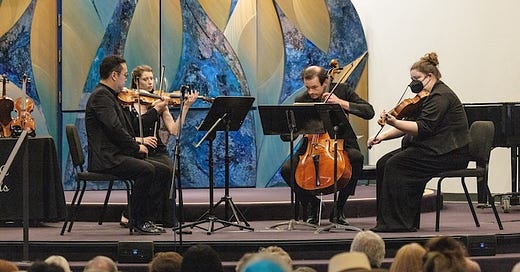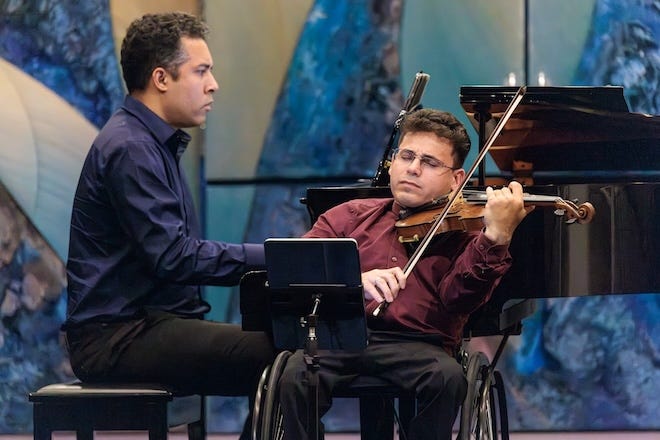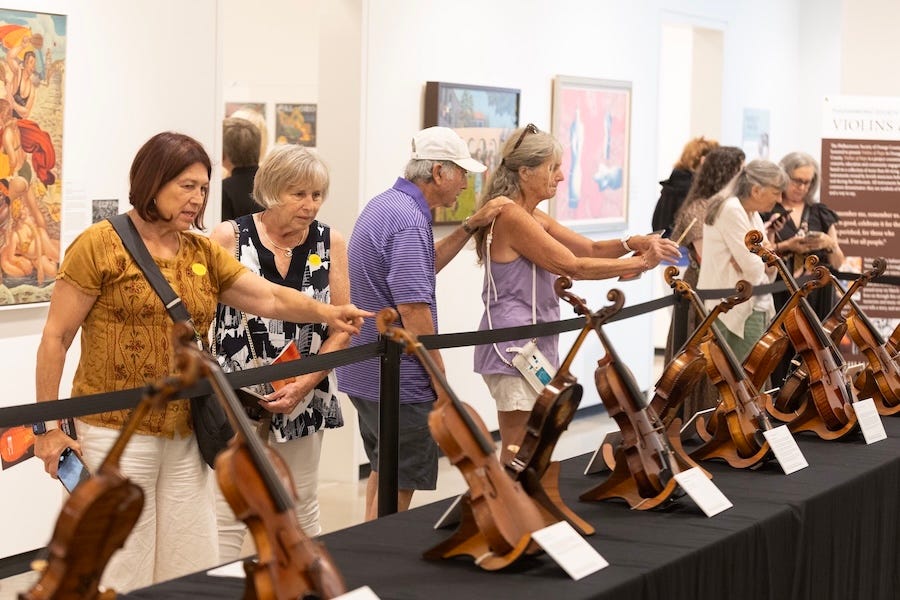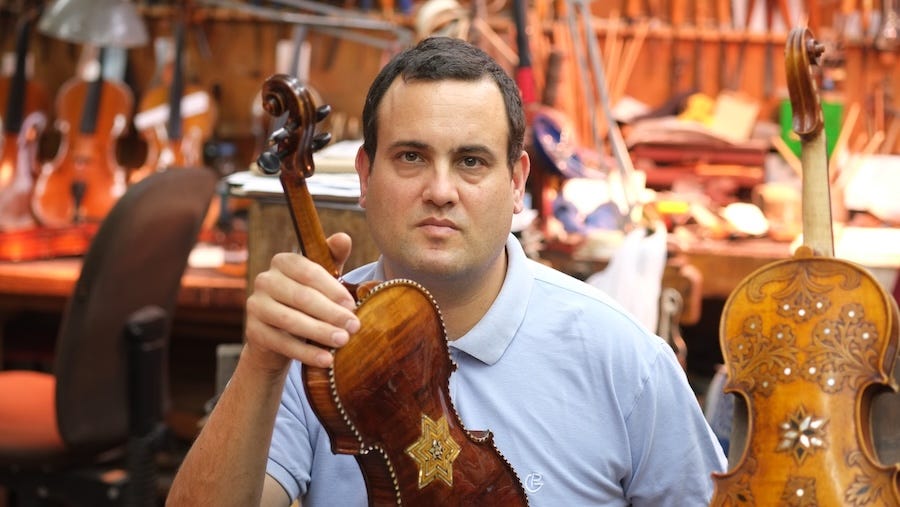Violins of Hope: Commemorating the Numerous People Who Died in the Holocaust, Along with Inspiration for Finding Hope, Resilience and Transformation in Life
Violins of Hope is the perfect forum to spread the important message about life, death and hope to the world.
Like a gentle soothing wind, the Tel Aviv project known as Violins of Hope swept through Orange County, California during the first two weeks of June 2025.
The multi-faceted Violins of Hope, sponsored in the OC by the Philharmonic Society of Orange County, includes more than 60 violins that had been owned and played on by Jewish musicians before and during the Holocaust. These magnificent violins have been traveling throughout this country and beyond since 2000, are exhibited during their travels as fine art pieces, and are played on by students to master violinists, in museums, universities, synagogues and concert halls. Each violin, which has been assiduously restored, possesses a story about the travails and hopes of its owners. Imbued within each violin’s wooden frame and strings are the sounds and vibrations created by those owners.
Master violinist Pinchas Zukerman, Pacific Symphony concertmaster Dennis Kim, and virtuoso violinist Ziv Ashkenazi performed with those violins during the Philharmonic’s 2025 presentations. The music that these and other violinists played included classical pieces by Mendelssohn and Dvořák, contemporary tunes by Gershwin, Jewish folk songs, lively klezmer music, and Theme from Shindler’s List by John Williams.
During past and current recitals and concerts, Violins of Hope co-founders Amnon Weinstein and his son, Avshi, relate heartwarming tales about the instruments’ origins and travels, and about the people who owned and played on them. Avshi also talks about his extensive family, including stories about his father and grandfather, Moshe Weinstein, the latter having settled in Israel (then Palestine) from Lithuania in 1939.
Dennis Kim, Pacific Symphony Concertmaster with members of the symphony’s string section at University Synagogue, Irviine, CA
The origins of Violins of Hope began with Moshe, a gifted violinist, who understood that the best way to make a living in Palestine was as a violin repairman or luthier. Having studied his craft with specialists in Europe, he repaired violins in Palestine throughout World War II.
Shortly after that war ended, Moshe was informed that nearly four hundred of his relatives had been murdered in the Holocaust. His grief was so intense that he was unable to talk to his son Amnon or to anyone about his deceased relatives. Yet he welcomed many Holocaust survivors to stay in his apartment until they figured out how to proceed with their lives. The presence of those distressed people strongly affected and haunted the young Amnon.
As Amnon grew up, and took over the family violin repair business, Holocaust survivors began bringing instruments to him that they had played on in Auschwitz and other death camps for repair or donations. In the book, Violins of Hope, 2014, James A. Grymes wrote, “By the 1990s…Amnon was finally ready to reclaim his lost heritage…he started reflecting not only on the Holocaust but on the role that music—specifically the violin—played in Jewish lives during that dark period. He began locating and restoring violins that were played by Jewish musicians during the Holocaust.” Amnon also began meeting members of the Israel Philharmonic Orchestra, many of whom were Holocaust survivors.
While getting to know these survivors and working on their legendary violins, Amnon began talking on the radio about the Holocaust and the violins he was collecting. He requested that listeners bring their violins to him, no matter their condition.
Niv Ashkenazi on Violin, Jason Stoll on Piano at University Synagogue, Irvine, CA
As people came to his Tel Aviv workshop, many with instruments they could no longer bear to play, they related stories about their lives, and about living in ghettos and concentration camps during the Holocaust. Amnon documented those stories, many of them relating how violinists were forced to play instruments in the death camps, often as other prisoners were being marched to the gas chambers.
He also heard stories about how violinists were treated more favorably than other prisoners, were given more food, enabling them to survive. For many prisoners, playing violins became their spiritual nourishment. “They played for their lives and to keep hope alive,” Avshi says. “Even in the worst of times there was hope.”
As Amnon lovingly restored the violins, he began perceiving them as instruments of hope, rather than of despair. While the term Violins of Hope was suggested by a friend in 2006 before a concert in Paris, it grew organically from the detailed repair work that Amnon and Avshi, his assistant, were devoting their lives and spirits to. The comment, “We give voice to the millions of people who have been silenced,” is attributed to Amnon.
Victor Frankl, a Holocaust survivor, Nobel Peace Prize nominee, and author of “Man’s Search for Meaning” © 1946, believed that individuals can find purpose and resilience while facing extreme adversity. His quote, "The will to meaning is the primary motivational force in man," exemplifies the Violins of Hope philosophy
Visitors viewing Violins of Hope on Display at Hilbert Museum of California Art, Orange, CA
In 2000, the first Violins of Hope concert and violin exhibition was held in Istanbul, with Amnon relating stories about the violins and their owners. As news of the project spread worldwide, musical organizations began requesting that Violins of Hope visit them to spread the important message about hope rising out of despair through music
“Our mission is to tell the world that the Holocaust happened,” Avshi (who grew up hearing many Holocaust stories) explains. “So many people don’t know what it means for six million people to have been murdered. We are educating them about the Holocaust. We are bringing the instruments and the souls of the people who played them alive.”
Violins of Hope has become a memorial for the numerous people murdered in the Holocaust, and an inspiration for finding hope, resilience and transformation in life.
Following the project’s Istanbul concert, Violins of Hope performed in Paris, Charlotte, North Carolina, Cleveland, Nashville and at the Berlin Philharmonic Hall in 2015, celebrating the seventieth anniversary of the Auschwitz liberation. The project has performed in Argentina, Mexico City, Guadalupe, Montreal and Calgary, among other places.
Avshi Weinstein, Co-Founder, Violins of Hope (all images courtesy, Philharmonic Society of Orange County)
Avshi explains that Violins of Hope is so popular that it travels to a different location each month, is fully booked for three years, and will soon travel to Colorado, Wisconsin, Iowa and Minnesota.
In Orange County, Violins of Hope musicians performed and its violins were displayed at four museums, at Soka University of America, the Musco Center for the Arts at Chapman University, University Synagogue in Irvine and other locations.
Among the stories that Avshi relates during the concerts and recitals is one about the Auschwitz Violin. Made in Germany around 1850, the violin was owned by a prisoner who played in the men’s orchestra in Auschwitz. The violin owner survived, but being very distraught after the war, he sold the instrument to a man named Abraham who bought it for his son Freddy. Years later Freddy heard about Violins of Hope and donated it to the project to be fully restored. Today, the violin is in excellent condition and has been played by master musicians in many countries in Violins of Hope concerts.
“The Holocaust is not easy to talk about,” Avshi Weinstein says. “But we have to make sure that people know that these events happened, as there is nothing to stop them from doing these things again unless we educate them."
Indeed, Violins of Hope is the perfect forum to spread this important message about life, death and hope to the world.






